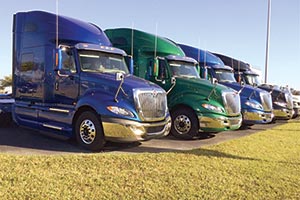Senior Reporter
Class 8 Fleet Nears 4 Million; New Registrations Up 11%

The nation’s fleet of Class 8 trucks in operation climbed 5% during the first nine months of the year to a record 3.93 million, IHS Automotive reported, driven in part by an 11% jump in registrations of new trucks in the third quarter.
Truck owners registered 67,176 new trucks with state governments during the third quarter, up from 60,686 in the same quarter last year.
For the year’s first nine months, fleets registered 197,746 heavy-duty trucks compared with 168,650 over the same period a year earlier, IHS said in its latest Polk division report on commercial vehicle registrations, published Nov. 18.
The nine-month registration surge was “just 13,000 units below the nine-month peak set in 2006, when registrations hit 210,760,” Gary Meteer Sr., IHS director of commercial solutions, told Transport Topics.
Also, Class 8 vehicles accounted for 36.5% of all 542,012 commercial vehicles registered. “Class 8’s best share in the first nine months since 2000,” Meteer added.
Fleets, especially large carriers, have accelerated their trade-in schedules, turning to new trucks both to improve fuel mileage compared with older models and to attract drivers, analysts said.
“The business continues to be pulled along by large fleets,” Meteer said.
In the first nine months, 49.7% of new Class 8 registrations were filed by fleets operating more than 500 vehicles, up from a 48.4% share during the same period a year ago, IHS said.
“Our outlook has been and continues to be for the peak in new registrations to be in the 2016 calendar year and then starting to decline,” Meteer said.
Richmond, Virginia-based Estes Express Lines has continued to add equipment this year to improve reliability and fuel efficiency, and add advanced safety technologies and operational enhancements, said Webb Estes, vice president of process improvement.
A less-than-truckload carrier, Estes Express ranks No. 15 on the Transport Topics Top 100 list of the largest U.S. and Canadian for-hire carriers.
Webb Estes said the company “has made a conscious effort especially over the last two years to improve our fleet. As a result, 40% of our Class 8 tractor inventory is now 2 years old or less.” He said the renewal effort will continue in 2016 with plans to replace an additional 930 tractors, then more than half of the company’s 6,700 tractors will be 3 years old or less.
In the secondary market, registrations of used trucks also grew, rising 10% to 70,072 in the third quarter compared with 63,421 in the corresponding quarter in 2014, IHS said.
Factory-installed natural-gas engines for the nine-month period were down 13.3% to 5,063 units compared with 5,837 in same period of the previous year, IHS reported.
The research firm also looked at third-quarter trailer registrations, 24-foot and longer, and found 2,111 new units, or 770 fewer than the 2,881 in the 2014 quarter.
New registrations for dry and refrigerated vans, combined, were down 4.9% from the level reported in the same 2014 period.
“But 2015 was still the fourth-best nine months of a calendar year since 2000,” Meteer said.
IHS noted a particularly large decline in the number of registrations of 28-foot pup trailers, with the number falling to 8,345 in 2015 from 19,398 in 2014.
“LTL carriers were delaying purchases of 28-foot pups, waiting for the 33-foot trailers to get approved [by Congress] in 2015,” said David Gilliland, vice president of national accounts at Great Dane Trailers. “It did not happen, and the LTL carriers placed their 48-foot and 53-foot needs.”

